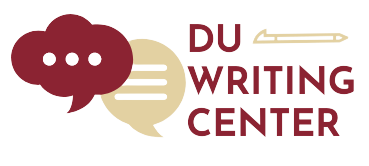by Stephanie Yamoah
This Spring we will be publishing a series of spotlight articles about multilingual students and faculty at DU. These articles are based on interviews that Dr. Kamila Kinyon and a group of multilingual students conducted about interviewees’ lived experiences, including continuing connection to heritage languages, role as writers and teachers at DU, and thoughts about multilingual and multicultural identity. This project is funded by a Faculty Research Fund Grant awarded to Dr. Kinyon for 2023-25. We welcome this opportunity to celebrate DU’s multilingual community.
Mina Khadem, a student at the University of Denver, reflects on her diverse heritage and upbringing, which greatly influenced her linguistic and cultural identity. She shares, “I’m originally from Denver, Colorado. But my mom is from Honduras, which is like a little Central American country. And then my dad is from Iran. So, at home, I grew up speaking Spanish because of my mom. My dad does not know Farsi, so I did not grow up speaking Farsi, but I have very strong connections to the Persian culture. I celebrate Nowruz, and we support my grandfather when he goes through Ramadan and other traditions. But yeah, that’s a little bit about my background.” This upbringing immersed her in Spanish, shaping her daily life and familial traditions.
Growing up in a bilingual household, Mina was accustomed to speaking English and Spanish. However, it wasn’t until she started school that she realized the uniqueness of her linguistic abilities. “I guess I didn’t realize that speaking multiple languages was unusual or not as common. I also went to a bilingual school when I was younger, so during the day, I would speak mainly in Spanish, and then I would come home and speak English with my dad and a variety of Spanish and English with my mom.” Reflecting on her language journey, Mina Khadem acknowledges the dissonance between her Central American-influenced Spanish and the European Spanish taught by her teachers, stating, “But I know my Spanish is mostly Central American in nature. But all my teachers were from Spain, and I now realize that I faced much criticism for my accent. And I was told my Spanish was wrong because it wasn’t the Spanish spoken in Spain.” This contrast between dialects presented challenges, yet it also enriched her understanding of language diversity and cultural nuances, contributing to her ability to navigate various linguistic contexts with empathy and openness.
As Mina transitioned to high school, she found herself in a more diverse environment, though one that was predominantly English-speaking. Despite the shift, Mina’s love for Spanish and her desire to maintain her connection to the language led her to seek opportunities to use and develop her linguistic skills. She found solace in connecting with other Spanish speakers and building relationships with “a few Spanish teachers who helped me get into college classes for Spanish so I could get more credit because I had already come in with high language proficiency, so they sent me to take some college classes instead. But that was kinda cool.”
Mina’s university experience has been a journey of self-discovery and community-building. As an International Studies major with a minor in Spanish, she has been able to explore her passion for languages and cultures while fostering a sense of belonging. She has been actively involved in the Spanish Department’s Heritage Speaker program, where “I’m a tutor for the heritage Spanish language program at DU. So, I work with Heritage Spanish speakers like myself, and I’ve been able to take on other types of translation opportunities. I’ve volunteered for Metrocare Denver, which helps provide people with food and other nutrition resources. I’ve also been able to interview quite a few Spanish speakers here in Colorado and kind of give them a voice as a student who can translate and do stuff like that.”
The Heritage Speaker program has been instrumental in Mina’s growth as a multilingual student. The program provides a space for students like Mina to analyze their unique linguistic experiences, improve their language skills, and engage in community-building activities. Mina’s involvement in the program has allowed her to “…connect with a lot of students on different levels. There was a student who came from Guatemala by herself, and we were able to get her to be a lot more comfortable in the DU community in general by talking to her and just helping her out with school.” As a student, she is able to share experiences, and create a supportive network as she indicated: “It’s not intimidating to go into these sessions because I’m also learning to0, I’m also taking classes, I’m also constantly overwhelmed like, let’s hang out for 30 minutes, talk about your class, and we’ll figure things out.”
Mina’s experiences as a multilingual student have shaped her worldview and fueled her passion for advocating for multilingual students. She believes the “University of Denver can better support its multicultural members by expanding language-specific programs and organizations, creating a more inclusive environment for students from diverse linguistic backgrounds.”
Mina’s story is a testament to the power of language and culture in shaping one’s identity. As she continues her journey at the University of Denver, Mina remains committed to fostering a sense of belonging for multilingual students and celebrating the richness of linguistic diversity. In her concluding remarks, Mina stresses: “Bilingual students have a place here at DU, and it’s important to emphasize that and include them in these types of communities.”

